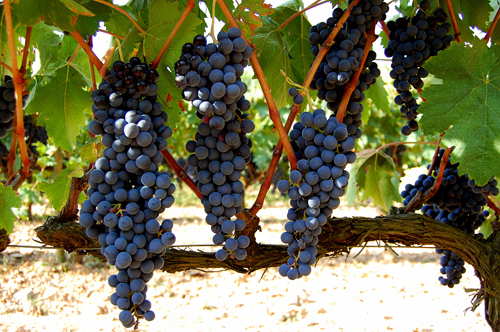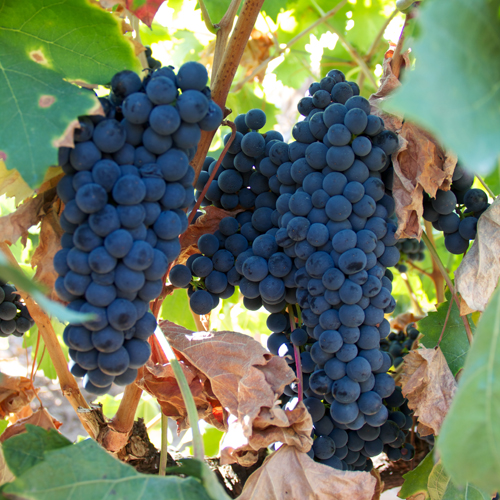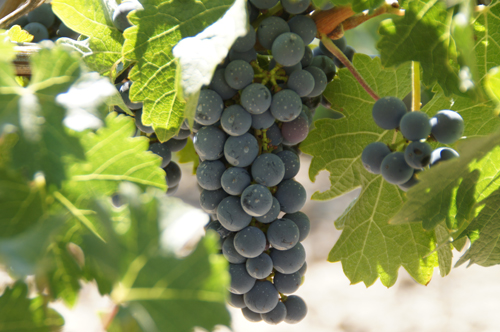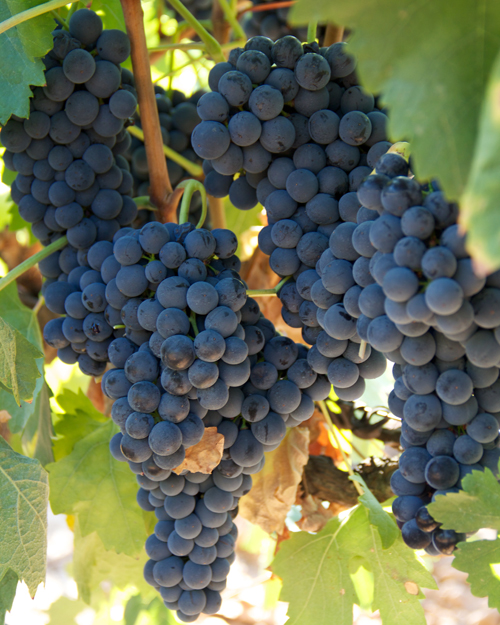Tempranillo grape variety
Tempranillo is a famous and ancient Spanish grape variety widely grown in this country and abroad for further processing into high quality red wines with a soft texture and timeless elegance.
Until recently, this variety was thought to be related to old French grapes. Pinot Noir... Allegedly, Pino cuttings were brought to Spanish soil by monks from Burgundy, making a pilgrimage to the Cathedral of Santiago de Compostela. However, recent genetic studies have disproved this theory. Thanks to the work of scientists, it became known that the ancestors of Tempranillo grew on the Iberian Peninsula a thousand years before our era. According to historians, they were first brought there by the Phoenicians. The immediate parents of the new hybrid were two other Spanish varieties: the white Albillo Mayor and the red Benedicto. The former is widely known to this day and is widely cultivated in the center of the Iberian Peninsula. The second is almost not cultivated, occasionally found only in the province of Aragon. Crossing most likely resulted from spontaneous hybridization.

Until the 17th century, Tempranillo's cultivation remained limited to mainland Spain, where it was cultivated in the cool northern provinces. In the regions of Rioja and Valdepeñas, it has become the most widespread, being the main grape for the production of the most outstanding local wines. Currently, of the 600 varieties growing in the country, our hero is the most cultivated - he accounts for up to 20% of the production of Spanish wine.
In Europe, the variety has also become widespread in Portugal, and recently it has begun to be actively cultivated all over the world: the areas occupied under it are growing very rapidly in Argentina, Chile, Peru, Mexico, USA, South Africa and Australia. This active distribution was made possible by the high plasticity and relatively simple cultivation of Tempranillo. At the same time, it exhibits certain requirements for the microclimate of the growing zone, which somewhat limits the geography of its distribution. In particular, grapes grow better at relatively high altitudes, although they can tolerate a much milder, flat climate.
With regard to its cultivation in different climatic conditions, experts say: “To obtain elegance and sufficient acidity, Tempranillo needs a cool climate. But it needs warmth to get high sugar levels and a thick skin, rich in tannins and pigments that determine its intense color. It is easiest to combine these two opposites in mountainous terrain, with a significant difference in daily temperatures. "

Agrobiological characteristics of the variety
The growth force of grape bushes is average and depends on a combination of factors associated with growing conditions. The crown of a young shoot is open, has a distinct crimson color along the edge and a cobweb pubescence of moderate or strong density. Young leaves are yellowish-bronze in color, also have a fairly intense pubescence. The formed leaves are large, rounded or slightly elongated in length, have five lobes and have an average degree of dissection. The color of the leaf blade is green, the surface is wrinkled or slightly bubbly, the reverse side is medium pubescent, the type of pubescence is mixed. The lateral notches are moderately deep, open, with parallel sides and a pointed bottom, or closed with almost no gap. The petiole notch is open, vaulted, or barely noticeably lyre-shaped. The denticles along the edge of the leaf are large, triangular with slightly curved edges, a wide base and sharp tops. The flowers are bisexual, pollination is sufficient and stable over the years. Shoot growth is average, internodes are long, stepson formation is insignificant.The vine ripens well, acquiring a yellowish brown color. In traditional cultivation zones, Tempranillo does not have problems with overwintering.
Bunches of grapes are large enough for a technical variety, of normal density, mainly cylindrical-conical, sometimes winged, noticeably elongated in length, weighing 200-300 grams. The combs are of medium length, light green, strong. The berries are medium in size, round or slightly pear-shaped with a flat top. In dense bunches, deformation of the grapes can be observed due to the tight fit to each other. The diameter of the berries is 15-17 mm, the average weight is 1.2-1.8 grams. The skin is quite thick, firm and elastic, dark blue, turning into black with an intense matt bloom of prune on the surface. The pulp of Tempranillo is juicy, slightly dense, and has a pleasant taste. The average number of seeds per berry is 1.6-2.1. The juice contains 21-23 grams / 100 ml of sugars, 5-6 g / l of titratable acids (of which malic acid - 1.6 g / l, tartaric - 3.8 g / l). The risk of wort oxidation is low. The potential alcohol content of wine is 13-14%.

The harvest of this variety is used in the vast majority of cases for processing into high-quality wine material. Sometimes quite saturated juices are prepared from grapes. Thanks to the thick skin, Temranillo wines are very elegant in color, highly tannic, suitable for long aging and the accumulation of a magnificent bouquet during its process. Literally one and a half to two years in oak barrels give them a very rich and deep taste. At the same time, wines from different places of growth have a completely unique taste and aroma. They are united by only one thing - with all their intense taste and color, they fascinate with their simultaneous lightness and softness. They do not have that heavy, thick oiliness that is often found in other red wines. The aroma of drinks made from Tempranillo, grown in cool climates, reveals tones of raspberries and black currants, and from the crops obtained in hot regions, wines with a bouquet of plums, jam and spices are produced.
It is possible to produce wine from Tempranillo not in pure form, but in a blend with other wine materials from more acidic varieties. Especially often, such an assemblage is practiced in a sultry cultivation climate, where the acid in the wort and wine is frankly insufficient.
The grapes ripen quite early in comparison with other dark-colored varieties, and in their homeland they are ready for harvest from the end of August. The required sum of active temperatures is 2600 ° C. They try not to overexpose the crop on the bushes, so as not to lose the acid, which is already in a certain deficit in the berries. The yield of the variety is quite high; in a suitable climate and proper care, it is not uncommon to obtain up to 10 or more tons per hectare. The fertility rate depends on the type of rootstock, ranging from 1.17 to 1.75 inflorescences per shoot. The frost resistance of the variety is not known for certain, since in Spain, with its mild climate, the passage of winter does not pose a particular problem for grapes.

Agrotechnical features
Tempranillo is a purebred representative of the European cultivated grape variety Vitis vinifera, which determines its rather high demands on growing conditions and care. For cultivation, the variety prefers a relatively cool mountain climate with high daily temperature ranges. It works well on light, stony and calcareous soils. Critically demanding of sufficient air and soil moisture. In arid conditions, it grows very depressed and sharply reduces productivity.
Grapes propagate mostly by grafted cuttings, due to instability to phylloxera.Tempranillo grows well with rootstocks such as Riparia x Rupestris 101-14 or Berlandieri x Riparia Kober 5BB. It is weakly resistant to fungal diseases. Strongly susceptible to powdery mildew, moderately susceptible to mildew, phomopsis and gray rot. In this regard, it requires complex treatment with fungicides according to the protocols for the protection of susceptible varieties. In addition, it is actively damaged by leafhoppers during the growing season, which is why it requires insecticidal treatment from it at the end of hatching of the larvae of the pest. Also, producers are advised to take care of protection from birds that can cause significant damage to the crop.
In its homeland, Tempranillo is grown in a standard non-sheltered culture, due to the absence of the risk of frost damage in winter. However, in a continental climate, it is necessary to provide for adequate protection of the grapes, primarily by forming bushes without a stem and covering them for the winter. To do this, you can try to use formations according to the principle of a multi-arm fan or an inclined cordon, convenient for removing the vine from the trellis in the fall and warming it. In some cases, you can experiment by applying a semi-covering shaping. At the same time, most of the bush will grow on a trunk without shelter, and the branch insulated for the winter, located on the lower lightweight tier, will become a kind of reserve in case the main one dies. With such a scheme, it is possible to empirically determine the suitability of each specific climate for growing a variety in a non-covering culture, without the risk of completely destroying the plant during the experiment.

Pruning Tempranillo should be done at an average length of fruit arrows - 6-8 eyes. The total load on the bush should not exceed 30 eyes or 20 fruitful shoots. During the growing season, sterile and weak shoots must break off. This grape variety is highly prone to overload, and if the grower ignores this problem, there is a risk of getting a harvest that will turn out to be a completely nondescript watery wine.
Harvesting should be done at the optimal time, determined by the ratio of sugar and acid in the juice of berries. It is unacceptable neither too early harvesting from the bushes, in which the necessary sugar accumulation of berries will not be achieved, nor overripening of the bunches, which can excessively reduce the acidity in them. In both cases, the end result will be a sharp decline in the quality of the future wine.
In fact, it must be recognized that Tempranillo, with all its wide distribution in recent years, remains largely an autochthonous variety, adapted and showing its best sides in its native, rather specific climate. That is why its introduction to other areas, countries and continents has been negligible for a long time. And only recently, in the wake of the growing popularity of Spanish wines, this aboriginal variety of grapes began to be widely cultivated all over the world, nevertheless, looking for places of growth similar to their native ones. It is quite possible that in our country it will eventually find a favorable ecological niche for cultivation, for example, in the highlands of the North Caucasus, and then domestic winemakers will be able to boast of wine that is not inferior in quality to Spanish.








